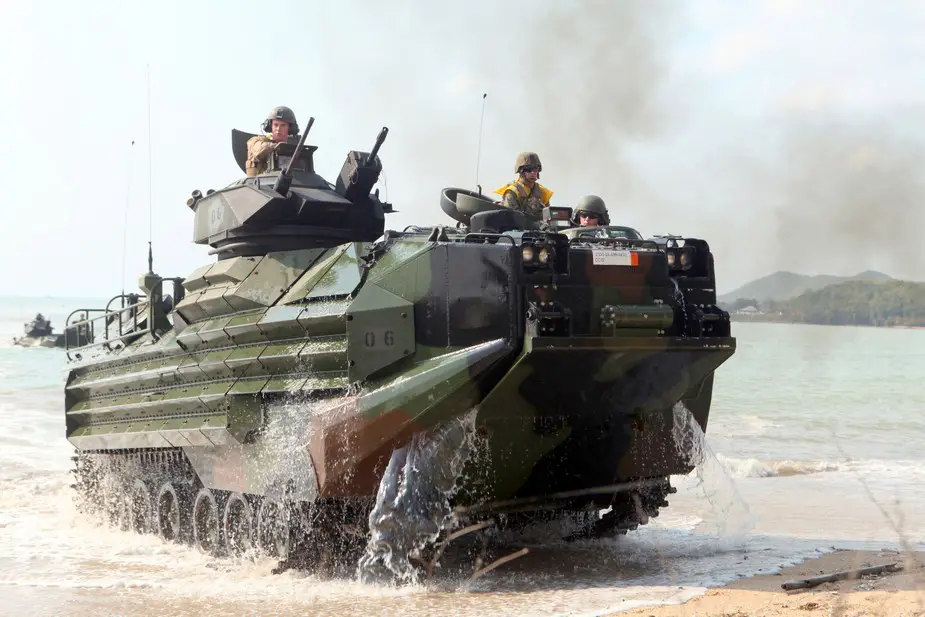Breaking news
U.S. Marines 2020 Budget: priority to near-term readiness, upgrades for high-end fight.
The U.S. Marine Corps wants to spend nearly a third of its Fiscal Year 2020 money on modernizing its equipment and nearly another third on rebuilding readiness, a top officer said, Megan Eckstein reports on USNI News. Lt. Gen. Brian Beaudreault, deputy commandant for plans, policies and operations, said last week that the service is requesting to spend $14 billion on modernization and $13.8 billion on near-term readiness, or about 30 percent of the total budget each.

AAV-P7A1 of the US Marine Corps (Picture source: USMC)
As reported on USNI News, Lt. Gen. Brian Beaudreault painted a picture of a future high-end fight the Marine Corps had to prepare for, with a slew of near- and long-term priorities for both the Marines and the Navy: the amphibious warships need upgrades to become more lethal and better netted with the rest of the naval force; the amphibious teams need to reduce their own electronic emissions while better sensing the adversary’s; and surface and aerial connectors need to be upgraded to better support maneuver and sustainment. The Navy needed to bolster the prepositioning force to better support logistics and resupply in a contested environment, the expeditionary Navy and Marine Corps needed to fully resource offensive mining and mine countermeasures work, and the Marine Corps needed to continue to invest in tactics and systems to win in an information warfare environment, he added.
With a hefty to-do list laid out to prepare for a future battle with a near-peer adversary, Beaudreault turned to the upcoming FY 2020 budget process. The Pentagon has sent its request to the Office of Management and Budget, which is currently closed due to the partial government shutdown. The federal budget rollout had been set for the first week in February, but it is unclear now when the budget request will be released.
Beaudreault previewed the Marines’ ask, noting $13.8 billion in readiness-rebuilding needs for aviation in particular. This 30 percent of the overall submission would cover four areas, he said: an initiative to improve depot readiness and therefore improve unit-level readiness; resources, engineers, support equipment and more to bring down non-mission capable maintenance rates; boosting parts-availability to lower non-mission capable supply rates; and fully resourcing squadron-level maintenance work to improve in-service repair rates.
The general said the Marine Corps is on track to reach its readiness goals in 2019, after seeing improvements in its numbers in 2018. The non-mission capable maintenance rates went from 14.1 percent in 2017 to 13.1 percent in 2018 and is expected to hit the goal of 10 percent by January 2020.
Non-mission capable supply rates dropped by 2 percent from 2017 to 2018 and should hit its 10-percent goal by February 2020, he said. And the service has already met its goal of 5 percent in-service repairs. Mission capable rates across all type/model/series aircraft has been improving as funding for parts, logistics, engineers, depots and more has increased in the past few years, he added.
On modernization, Beaudreault said $14 billion, or 31 percent of the Marines’ budget request, would support the service’s preparations for a higher-end distributed naval fight. “The priorities are building a command and control integrated environment, conduct operations in the information environment such as providing greater support to our [Marine Expeditionary Force] Information Groups,” he said.
“We’re going to continue to enhance long-range precision fires, F-35 procurement, our MUX (Group 5 unmanned aerial system), our LOCUST – which is the swarming technologies for unmanned systems – medium-range air defense systems, G/ATOR radars, things of that nature. Protected mobility, such as the [Amphibious Combat Vehicle] and the [Joint Light Tactical Vehicle]. And then in logistics and close-combat lethality, things like purchasing M27 weapons, better [night-vision goggles] for our Marines, squad-level [unmanned aerial systems], modular handguns, utility tactical vehicles.”
Beaudreault later elaborated on the progress in development Marine Expeditionary Force (MEF) Information Groups (MIGs), calling them “a critical operational success” as they’ve been rolled out recently and proving to be able to support Marines’ maneuver while denying the enemy freedom of action. “We’re looking to develop scalable and deployable ops in the information environment teams to support organizations like Task Force Southwest in Afghanistan, and very similar teams for future [Amphibious Ready Group/Marine Expeditionary Unit] deployments. We’ve exercised the MIG construct at Trident Juncture, the largest NATO exercise in decades – we delivered effects in a contested information environment against a near-peer threat,” he said of the previous MIG development efforts.
“So we operationalized the MEF Information Group capabilities, and the focus will remain on standardizing and codifying standards and policies across the MIGs, across the Corps” in such a way that the entire service can see increased battlespace awareness, increased cyber capabilities, and more integrated information and intelligence to support warfare operations.


























